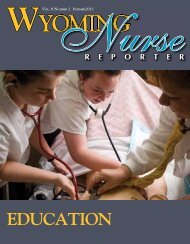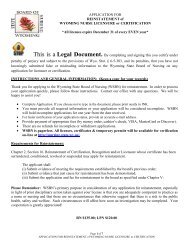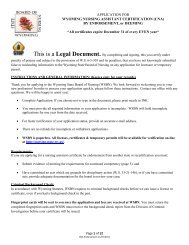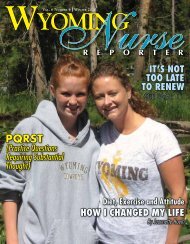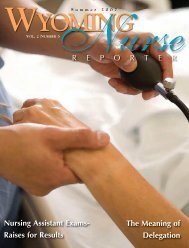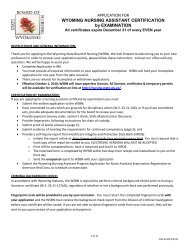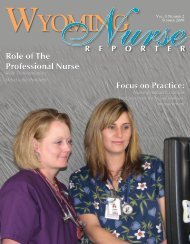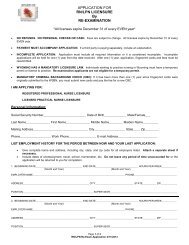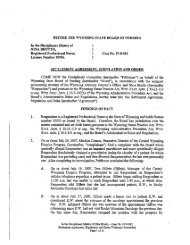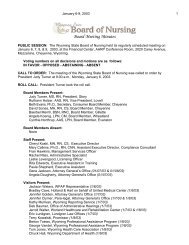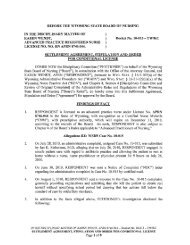Revised 07/02/2010 CHAPTER 3 STANDARDS OF NURSING ...
Revised 07/02/2010 CHAPTER 3 STANDARDS OF NURSING ...
Revised 07/02/2010 CHAPTER 3 STANDARDS OF NURSING ...
- No tags were found...
You also want an ePaper? Increase the reach of your titles
YUMPU automatically turns print PDFs into web optimized ePapers that Google loves.
Section 1. Statement of Purpose.<strong>CHAPTER</strong> 3<strong>STANDARDS</strong> <strong>OF</strong> <strong>NURSING</strong> PRACTICE(a)The purpose of the board in adopting rules and regulations in this chapter is to:(i) Communicate board expectations and provide guidance for nursesregarding safe nursing practice.(ii) Articulate board criteria for evaluating the practice of nursing todetermine if the practice is safe and effective.(iii) Clarify the scope of practice for the registered professional nurse,advanced practice registered nurse (see Chapter 4), and licensed practical nurse.(iv) Identify behaviors which may impair the licensee's ability to practice withreasonable skill and safety, which include, but are not limited to:(A)(B)(C)(D)(E)(F)(G)(H)(I)(J)Fraud and deceit;Unsafe practice;Misappropriation of property;Abandonment;Abuse, including sexual abuse;Neglect;Chemical dependency;Drug diversion - self/others;Sale or unauthorized use of controlled/illicit drugs;Criminal conviction;(K) Failure to supervise or to monitor the performance of acts by anyindividual working under the licensed nurse's direction;(L)(M)Unprofessional conduct; andBoundary violations, including sexual boundaries.(b) The standards of nursing practice interpret the statutory definitions ofprofessional, advanced practice and practical nursing. The standards of nursing practice evolvefrom the nursing process and national standards.(c)the board.Violations of the standards of nursing practice may result in disciplinary action by3-1<strong>Revised</strong> <strong>07</strong>/<strong>02</strong>/<strong>2010</strong>
Section 2. Standards of Nursing Practice for the Registered Professional Nurse(a)Accountability.(i)The registered professional nurse shall:nursing;(A)Have knowledge of the statutes and regulations governing(B) Practice within the legal boundaries for nursing through thescope of practice authorized in the Wyoming Nurse Practice Act and the board’s administrativerules and regulations;(C)Demonstrate honesty and integrity;(D) Base professional decisions on nursing knowledge and skills, theneeds of clients and the expectations delineated in professional standards;(E) Accept responsibility for judgments, individual nursing actions,competence, decisions and behavior;(F) Maintain continued competence through ongoing learning andapplication of knowledge to nursing practice;authorities;(G)Report unfit or incompetent nursing practice to recognized legal(H) Participate in the development of continued competency in theperformance of nursing care activities for nursing personnel and students.(b)Implementation of the nursing process.(i)The registered professional nurse:(A) Conducts a comprehensive health assessment that is anextensive data collection (initial and ongoing) regarding individuals, families, groups, andcommunities.(I) Collecting objective and subjective data fromobservations, examinations, interviews, and written records in an accurate and timely manner.The data includes, but is not limited to:(1.) Biophysical and emotional status;(2.) Growth and development;background;(3.) Cultural, religious and socioeconomic(4.) Family health history;members;(5.) Information collected by other healthcare team3-2<strong>Revised</strong> <strong>07</strong>/<strong>02</strong>/<strong>2010</strong>
(G)Seeks clarification of orders when needed;(H) Implements treatments and therapy, including medicationadministration and independent nursing functions;(I) Contributes to the formulation, interpretation, implementation,and evaluation of the objectives and policies related to nursing practice within the employmentsetting;(J) Participates in the evaluation of nursing practice through qualityassurance activities including peer review;(K) Obtains orientation/training for competence when encounteringnew equipment and technologies or unfamiliar care situations;(L)(M)appropriate interventions;Provides client surveillance and monitoring;Identifies changes in client’s health status and implements(N) Evaluates the impact of nursing care, the client’s response totherapy, the need for alternative interventions, and the need to communicate and consult withother healthcare team members;(O)Documents nursing care and responses to interventions;(P) Intervenes on behalf of the client when problems are identifiedand revises care plan as needed;health status;(Q)(R)Recognizes individual characteristics that may affect the client’sTakes preventive measures to protect the client, others, and self.(ii)Advocates for the client.(A)(B)Respects the client’s rights, concerns, decisions, and dignity;Identifies client needs;(C) Accepts only client care assignments for which educationallyprepared and adequately trained;(D)Promotes safe client environment;(E) Communicates client choices, concerns, and special needs withother healthcare team members regarding:(I)(II)(III)Client status, progress, and concerns;Client response or lack of response to therapies;Significant changes in client condition.3-4<strong>Revised</strong> <strong>07</strong>/<strong>02</strong>/<strong>2010</strong>
oundaries;(F)Maintains appropriate professional boundaries, including sexual(G)disclose the information;(H)Maintains client confidentiality unless obligated by law toAssumes responsibility for own decisions and actions;(I) Conducts practice without discrimination on the basis of age,race, religion, sex, life style, national origin, medical diagnosis, or handicap.(iii)Organizes, manages, and supervises the practice of nursing.(A) Assigns to another only those nursing measures that fall withinthat nurse’s scope of practice, education, experience, and competence or unlicensed personsdescription;(B) Delegates to another only those nursing measures that theperson has the necessary education, skills, and competency to accomplish safely and as outlinedin Chapter 9;(C) Matches client needs with personnel qualifications, availableresources and appropriate supervision;delegated activity;(D)Communicates directions and expectations for completion of the(E) Supervises others to whom nursing activities are delegated orassigned by monitoring performance, progress, and outcomes; and ensures documentation of theactivities;(F)(G)Provides follow-up on problems and intervenes when needed;Evaluates the effectiveness of the delegation or assignment;(H) Evaluates data as a basis for reassessing client’s health status,modifying nursing diagnoses, revising plans of care, and determining changes in nursinginterventions;(I)(J)Retains professional accountability for nursing care;Promotes a safe and therapeutic environment by:care environment;(I)(II)Providing appropriate monitoring and surveillance of theIdentifying unsafe care situations;(III) Correcting unsafe care situations or referring unsafecare situations to appropriate management level when needed.3-5<strong>Revised</strong> <strong>07</strong>/<strong>02</strong>/<strong>2010</strong>
(K) Teaches and counsels client and families regarding healthcareregimen, which may include, but is not limited to, general information about health and medicalcondition, specific procedures, wellness, and prevention;(iv)Participates as a member of an interdisciplinary healthcare team.(A) Functions as a member of the healthcare team, collaboratingand cooperating in the implementation of an integrated, client-centered healthcare plan;(B)(C)disclose the information.Respects client property and the property of others;Protects confidential information, unless obligated by law toSection 3. Standards of Nursing Practice for the Licensed Practical Nurse(a)process.Standards related to the licensed practical nurse's contribution to the nursing(i)The licensed practical nurse shall:(A)Contribute to the nursing assessment by:(I) Collecting, reporting, and recording objective andsubjective data in an accurate and timely manner. Data collection includes observations about thecondition or change in condition of the client.care by:(B)Participate in the development and modification of the plan of(I)(II)(III)Providing data;Contributing to the identification of priorities;Contributing to setting realistic and measurable goals;(IV) Assisting in the identification of measures to maintaincomfort, support human functions and responses, maintain an environment conducive to wellbeing, and provide health teaching and counseling; andand needs of clients.(V)Basing nursing decisions on nursing knowledge, skills,(C)Participate in the implementation of the plan of care by:(I) Carrying out such interventions as are taught in boardapprovedcurriculum for practical nurses and as allowed by institutional policies;(II) Providing care for clients in basic patient care situationsunder the direction of a licensed physician, dentist, advanced practice registered nurse, orlicensed professional nurse. Patient care situations as determined by a licensed physician,dentist, advanced practice registered nurse, or licensed professional nurse mean the followingtwo (2) conditions prevail at the same time:3-6<strong>Revised</strong> <strong>07</strong>/<strong>02</strong>/<strong>2010</strong>
(1.) The client's clinical condition is predictable andthe responses of the client to the nursing care are predictable;(2.) Medical or nursing orders do not changefrequently and do not contain complex modifications.(III) Providing care for clients in complex patient caresituations under the supervision of a licensed physician, dentist, advanced practice registerednurse, or licensed professional nurse. Complex patient care situations as determined by alicensed physician, dentist, advanced practice registered nurse, or licensed professional nursemean any one or more of the following conditions exist:(1.) The client's clinical condition is not predictable;(2.) Medical or nursing orders are likely to involvefrequent changes or complex modifications; or(3.) The client's clinical condition indicates care thatis likely to require modification of nursing procedures in which the responses to the nursing careare not predictable.(IV) Initiating appropriate standard emergency proceduresestablished by the institution until a licensed physician, dentist, advanced practice registerednurse or registered professional nurse is available;health;care;(V)(VI)Providing an environment conducive to safety andDocumenting nursing interventions and responses to(VII) Communicating nursing interventions and responses tocare to appropriate members of the healthcare team.(D) Contribute to the evaluation of the responses of individuals orgroups to nursing interventions by:(I) Documenting evaluation data and communicating thedata to appropriate members of the healthcare team;of the evaluation.(II)Contributing to the modification of the plan on the basis(b) Standards relating to the licensed practical nurse's responsibilities as a memberof the healthcare team.(i)The licensed practical nurse shall:nursing;(A)Have knowledge of the statutes and regulations governing(B)actions and competency;Accept individual responsibility and accountability for nursing3-7<strong>Revised</strong> <strong>07</strong>/<strong>02</strong>/<strong>2010</strong>
(C) Function under the direction of a licensed physician, advancedpractice registered nurse, dentist, or registered professional nurse;(D)and other appropriate sources;Seek guidance and consult with registered professional nurses(E) Obtain direction and supervision as necessary whenimplementing nursing interventions;(F) Accept client care assignments from the licensed physician,advanced practice registered nurse, dentist, or registered professional nurse only for which theyare educationally prepared and adequately trained;(G)Function as a member of the healthcare team;(H) Contribute to the formulation, interpretation, implementation, andevaluation of the objectives and policies relating to practical nursing practice within theemployment setting;(I) Participate in the evaluation of nursing practice through qualityassurance activities, including peer review;(J) Report unfit or incompetent nursing practice to the board.Report unsafe conditions for practice to recognized legal authorities;(K) Delegate to another only those nursing interventions which aperson is prepared or qualified to perform;delegated;(L)Provide direction for others to whom nursing interventions are(M)performed under direction;(N)interventions. See Chapter 9;Evaluate the effectiveness of delegated nursing interventionsRetain accountability for nursing care when delegating nursing(O) Conduct practice without discrimination on the basis of age,race, religion, sex, life-style, national origin, or disability;(P) Respect the dignity and rights of clients and their significantothers, regardless of social or economic status, personal attributes, or nature of health problems;(Q)disclose the information;(R)(S)Protect confidential information, unless obligated by law toRespect the property of all individuals and facilities;Maintain boundaries, including sexual boundaries;(T) Participate in the development of continued competency inperformance of nursing care activities for auxiliary personnel;3-8<strong>Revised</strong> <strong>07</strong>/<strong>02</strong>/<strong>2010</strong>
(U) Comply with the standards of nursing practice, the rules andregulations, and the Wyoming Nurse Practice Act;(V)Demonstrate honesty and integrity;(W) Maintain continued competency through ongoing learning andapplication of knowledge to nursing practice;(X) Participate in the development of continued competency in theperformance of nursing care activities for nursing personnel and students;(Y) Obtain orientation/training for competency when encounteringnew equipment and technology or unfamiliar care situations;(Z)Implement appropriate aspects of client care in a timely manner:healthcare plan;(I)(II)Provide assigned and delegated aspects of client’sImplement treatments and procedures.(AA)(BB)(CC)Administer medications according to standards of practice;Document care;Participate in nursing management:(I) Assign and delegate nursing activities for patients/clientsto assistive personnel as outlined in Chapter 9;nursing manager;(II)Observe nursing measures and provide feedback to(III)delegated and assigned activities.Observe communications and document outcomes ofnursing care plan.(DD)(EE)Take preventive measures to protect client, others, and self;Teach and counsel clients and families in accordance with the(c)Expanded role for the licensed practical nurse administering intravenous therapy.(i)Certification, renewal, reinstatement, discipline.(A)Initial certification.license;(I)(II)Hold an active, unencumbered Wyoming practical nurseSubmit required application and fees; and3-9<strong>Revised</strong> <strong>07</strong>/<strong>02</strong>/<strong>2010</strong>
(III) Submit official evidence of completion of a boardapprovededucational program of study in basic, advanced or combined basic/advancedintravenous therapy for licensed practical nurses.(B)Renewal of certification.(I)Submit renewal application and fee; and(II) Submit documentation of completion of a minimum often (10) contact hours of continuing education and/or in-service education in intravenous therapywithin the previous two (2) year period; or(III) Submit documentation of successful completion of aboard-approved licensed practical nurse intravenous therapy refresher course.(C) Expanded role licensed practical nurses may reinstate a lapsedintravenous certification under the following conditions:than five (5) years:practical nurse license;(I)Certification lapsed more than two (2) years but lessa. Hold an active, unencumbered Wyomingb. Submit reinstatement application and fee;c. Successful completion of a board-approvedlicensed practical nurse intravenous therapy refresher course; ord. Successful completion of a board-approvedlicensed practical nurse intravenous therapy course;(II)Certification lapsed for 5 years or more:practical nurse license;a. Hold an active, unencumbered Wyomingb. Submit reinstatement application and fee;c. Complete a board-approved basic, advanced orcombined licensed practical nurse intravenous therapy course.(D)Certification by endorsement.(I) Proof of successful completion of a board-approvedbasic, advanced or combined licensed practical nurse intravenous therapy course.(ii) Scope of practice for the licensed practical nurse administeringintravenous (IV) therapy:(A) The licensed practical nurse may perform the followingprocedures under the direction of a registered nurse, physician, advanced practice registerednurse, or dentist, due to the basic knowledge and skills acquired in a state board-approvedpractical nursing program:3-10<strong>Revised</strong> <strong>07</strong>/<strong>02</strong>/<strong>2010</strong>
infusions;relating to IV fluid treatment.(I)(II)(III)(IV)Observe and monitor IV fluid management;Calculate and maintain flow rate of peripheral IVDiscontinue peripheral IV infusions; andReport and document observations and procedures(B) In addition to IV related activities within the scope of any licensedpractical nurse, the licensed practical nurse certified in basic IV therapy may perform the followingacts of IV therapy:(I)and medications via a peripheral route:catheters.Initiate the administration of board-approved IV fluids(1.) The peripheral route does not include midline(II) Administer IV fluids and medications including electrolytesolutions with vitamins and/or potassium, antibiotics and hydrogen receptor blockers providedsuch fluids and medications are appropriate for IV administration;(III)Change IV tubing(s) and dressings;(IV) IV fluids and medications must be commerciallyprepared or premixed and labeled by a registered pharmacist.(V) Maintain patency of a peripheral intermittent vascularaccess device using a saline flush solution or non-therapeutic dose of heparin flush solution;(VI)and collect data from a PCA pump;(VII)Monitor a patient controlled administration (PCA) pumpPerform phlebotomy; and(VIII) Activate a drug admixture delivery system that has beenprepared and labeled by a pharmacist, registered nurse or other qualified person.(iii)The licensed practical nurse certified in basic IV therapy shall not:(A) Initiate, regulate, add, or administer medications to ordiscontinue a midline or central venous line except as provided elsewhere in this section.(B)Administer or add the following to a peripheral venous line:(I)(II)IV push or bolus medications;IV medications other than those in Section 3(c)(B)(II).(C)(D)Inject medication into an auxiliary fluid chamber;Mix or label IV medications or total parenteral nutrition (TPN);3-11<strong>Revised</strong> <strong>07</strong>/<strong>02</strong>/<strong>2010</strong>
expanders;(E)(F)Program or re-program a PCA pump;Administer blood, blood components, plasma, plasma(G) Administer analgesics, antineoplastics, autonomic nervoussystem agents, cardiovascular agents, central nervous system agents, oxytoxic agents, orradiologic agents;(H) Initiate and/or maintain pediatric IV therapy (aged twelve (12)years and under); nor discontinue pediatric IV therapy (aged birth to four (4) years);home setting.(I)(J)Flush or aspirate a central venous line or arterial line; orPerform basic acts of IV therapy as listed in this section in the(iv) In addition to IV related activities within the scope of a licensed practicalnurse certified in basic IV therapy, the licensed practical nurse certified in advanced IV therapymay perform the following acts of IV therapy:(A)Mix and label IV medications;(B) Draw up, label and administer medications that are not restrictedby institutional policies or as limited elsewhere in this section;(C) Assist the registered professional nurse in the administration ofmidline or central venous infusion of approved IV fluids by:(I)(II)(III)(IV)(V)Checking the flow rate;Maintaining patency by use of saline/heparin flush;Changing the tubing(s) and site dressing(s);Administering TPN; andObtaining a blood sample.peripheral IV therapy.(D)Discontinue pediatric (aged five (5) to twelve (12) years)(v) The licensed practical nurse who has satisfactorily completed anadvanced course of IV therapy for licensed practical nurses shall not:(A) Administer analgesics; antineoplastics; autonomic nervoussystem agents; cardiovascular agents; central nervous system agents; oxytocic agents orradiologic agents;(B) Start and/or maintain pediatric IV therapy (aged twelve (12)years and under); and discontinue pediatric IV therapy (aged birth to four (4) years);(C)Administer blood and blood components;3-12<strong>Revised</strong> <strong>07</strong>/<strong>02</strong>/<strong>2010</strong>
(D)(E)(F)(G)Administer experimental drugs;Flush or aspirate an arterial line;Discontinue a central line; orInject medications via direct IV route; bolus, push.(vi) Upon successful completion of the basic and advanced IV TherapyCourse, institutional education, and in accordance with institutional policy, the licensed practicalnurse may perform the following nursing functions in non-acute (chronic) dialysis:(A) Initiate and discontinue dialysis treatments using an establishedaccess – including subclavian, internal jugular, femoral vein, fistula and right atrial catheters;(B)Perform peripheral venipuncture for the purpose of hemodialysis;(C) Withdraw blood and heparinized saline from the variousaccesses for the purpose of removing the heparin and establishing patency;for a lab specimen;(D)Withdraw blood from access for the purpose of obtaining blood(E) Administer IV medications and solutions during hemodialysisunless restricted by institutional policy;(F)(G)(H)Flush tubing of access device;Perform dressing changes to various access sites; andDiscontinue peripheral venous access lines.(v) Unless otherwise specified in these regulations, the licensed practicalnurse certified in IV therapy may perform basic and advanced acts of IV therapy if the supervisoris physically on the premises where the patient is having nursing care provided.(vi)Minimum program requirements.(A) The IV therapy program must utilize the board- approvedstandardized IV therapy curriculum; and(B) Shall be offered and administered by a nursing educationprogram in a post secondary institution of higher learning in Wyoming, in a board-approvededucational institution, an approved provider of continuing education or a licensed health carefacility.Section 4. Disciplinary Procedures for Licensed Practical Nurses and RegisteredProfessional Nurses.(a)Grounds for Discipline:(i) Engaging in any act inconsistent with uniform and reasonable standardsof nursing practice, including but not limited to:3-13<strong>Revised</strong> <strong>07</strong>/<strong>02</strong>/<strong>2010</strong>
(A) Fraud and deceit including, but not limited to, omission ofrequired information or submission of false information written or verbal;or technological;drugs;(B)(C)(D)(E)(F)(G)(H)(I)(J)(K)(L)Performance of unsafe client care;Misappropriation or misuse of property;Abandonment;Abuse, including emotional, physical or sexual abuse;Neglect, including substandard care;Violation of privacy or confidentiality in any form, written, verbal,Drug diversion-self/others;Sale, unauthorized use, or manufacturing of controlled/illicitCriminal conviction;Unprofessional conduct;Boundary violations, including sexual boundaries;(M)including, but not limited to:Failure to comply with reasonable requests from the boardand/or petition and complaint;renewal information;disclose required information;(I)(II)(III)(IV)(V)Responses to complaints;Responses to formal pleadings such as notice of hearingResponses to requests regarding application and/orWritten response to request for explanation for failure toFailure to appear at properly noticed hearings.(N)Impairment.(I)(II)Lack of nursing competence;Mental illness;(III) Physical illness including, but not limited to, deteriorationthrough the aging process or loss of motor skills; or(IV)Chemical or alcohol impairment/abuse.3-14<strong>Revised</strong> <strong>07</strong>/<strong>02</strong>/<strong>2010</strong>
(ii) Failure to conform to the standards of prevailing nursing practice, inwhich case actual injury need not be established.(b)Disciplinary Records.(i) The board shall maintain records of disciplinary actions and makeavailable public findings of abuse, neglect, or misappropriation of property or other disciplinaryfindings.(c)Disciplinary Notification.(i) The board shall notify the registered professional nurse or licensedpractical nurse’s employer, if applicable, of the disciplinary action.3-15<strong>Revised</strong> <strong>07</strong>/<strong>02</strong>/<strong>2010</strong>



